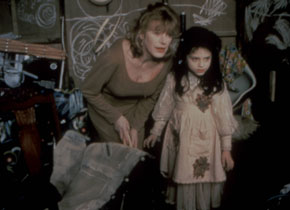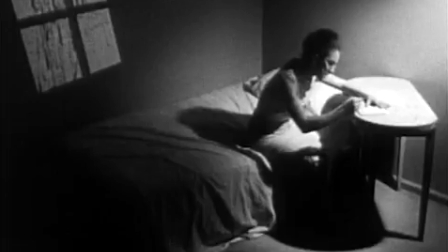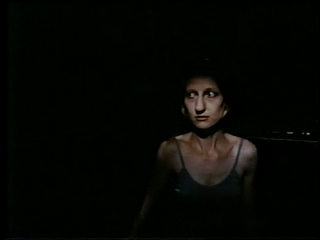Written for a Sara Driver retrospective at the Thessaloniki International Film Festival, held in early November 2011. — J.R.
All four of Sara Driver’s works belong to what the French call la fantastique — a conflation of fantasy with surrealism, science fiction, comics, horror, sword-and-sorcery, and the supernatural that stretches all the way from art cinema to exploitation by way of Hollywood. But it’s hard to find many other stylistic affinities between them, and only a few thematic overlaps. A 48-minute piece of Poelike horror set inside the mind of a schizophrenic in rural New Jersey (You Are Not I, 1981), closely adapted from a Paul Bowles story; a pulpy, scary feature-length fantasy about Oriental curses set over a few blocks in lower Manhattan (Sleepwalk, 1986); a gentle, nonscary comedy partly inspired by the whimsical 1937 Hollywood feature Topper, about the encounter between a jazz musician and two female ghosts in a small seaport town (When Pigs Fly, 1993); and a short documentary about the history and diverse arcane local details of Driver’s own neighborhood (The Bowery, 1994), which also served as the setting for the very different Sleepwalk.

That doesn’t mean that there aren’t various connections between these works going well beyond the recurrence of various collaborators. Think of the dense and hyperactive soundtracks of all four, the downscale milieus, the trancelike rhythms, the layered relation of distant past to present (bringing to mind the fact that Driver spent her junior year in college studying archeology in Athens), and, in the three fictional narratives, the depictions of bullying power-mongers and solitary children, the dreamy passivity of seemingly hapless protagonists, and chaotic eruptions of various kinds occurring in the midst of their compulsive routines, leading to major plot developments in all three cases. (With the help of supernatural intervention, a copy shop in Sleepwalk and an Irish pub in When Pigs Fly both go haywire with a comparable anarchic exuberance.)
Maybe the second and third items in Driver’s filmography are fantasies and maybe the fourth is non-fiction, but the first item is radical enough to confound both categories. Its formal strategies involving both sound and image can be encapsulated in three sentences from the Bowles story, all included in the offscreen, first-person narration: “It seemed to me that life outside was like life inside. There was always somebody to stop people from doing what they wanted to do.” And, “I often feel that something is about to happen, and when I do, I stay perfectly still and let it go ahead.” This results in a sustained ambiguity about what qualifies as schizophrenic subjectivity and what qualifies as “realistic” objectivity, with a similar muddle about which is “better” (meaning more attractive or bearable), “insanity” or “normality”. This is why we’re already confounded in the first two shots about what constitutes an event unfolding in real time (even if it’s motionless) and what constitutes a freeze-frame (even if it proves to have moving parts).
If we insist, we can “translate” the plot into something fairly coherent: a schizophrenic woman (the narrator) breaks free from her rural asylum after an auto accident and gets taken to her sister’s house by someone who assumes she’s in shock rather than crazy; once the sister brings over a couple of neighbors and orders an ambulance, the narrator convinces herself she can exchange bodies with her sister, who gets carted off in the ambulance while the narrator remains calmly seated on her sister’s living-room sofa. But our moment-to-moment experience of You Are Not I deprives us of such comforts, even the implied reassurance of the simple title. Moreover, ugly “normality” and all it represents are made to seem more grotesque and hysterical and less aesthetically pleasing than the narrator’s quiet self-containment.
After beginning her career with a staggering masterpiece that gives no quarter, Driver has devoted her subsequent work to softer, quieter negotiations with both her transgressive instincts and the workaday, everyday world she knows and inhabits. Sleepwalk, her first full-length feature, showing elements of both art film and exploitation – with Suzanne Fletcher, the schizophrenic in You Are Not I, again playing the lead role, but this time as the sanest adult (and with Phil Kline again providing the highly atmospheric score) — unfolds in a universe that is both mundane and erratic even according to the usual rules of fantasy fiction; one might say that it fully enters the “real” world in some recognizable form only towards the end, after a car gets stolen.
But first impressions shouldn’t necessarily be trusted when it comes to Driver’s eccentricities. Initially it appears that the slender story of When Pigs Fly digresses or at least swerves for the sake of a dream sequence (human or canine) or a flight of fancy that turns a piano lesson with Thelonious Monk’s “Misterioso” into the equivalent of a magic carpet ride over the countryside or Maryanne Faithfull singing “Danny Boy,” or Alfred Molina singing an Irish ditty of his own. But on closer inspection, all these supposed indulgences have something to do with plot and character development — and it’s worth adding that in Driver’s world, plot invariably is character, So When Pigs Fly turns out to be the most conventionally charted of her films, with a clearly delineated hero achieving some form of salvation and a villain achieving some form of comeuppance, in both cases through a settling of accounts in relation to an unresolved past.
Driver’s penchant for combining folk tales from different cultures — whether to form the Chinese tale being recounted and translated in Sleepwalk or to guide her selection of directors in an episodic feature of folk tales that she’s currently preparing — seems to reflect the neo-Jungian assumption that the diverse inhabitants of melting pots have more in common than they realize. By the same token, being “haunted” in The Bowery and When Pigs Fly seems to mean having more friends than you think you do. And in all her work, inspired casting (Fletcher, Molina, writer Luc Sante) is simply part of her talent for telling stories.






